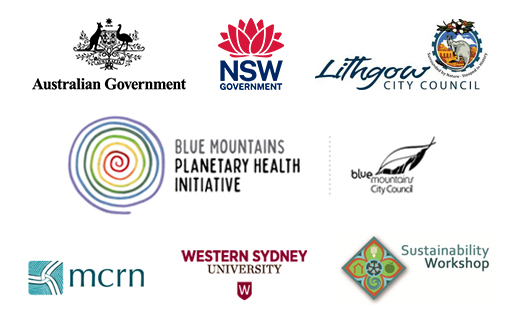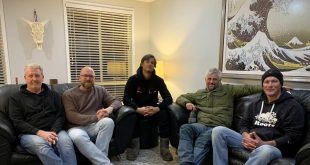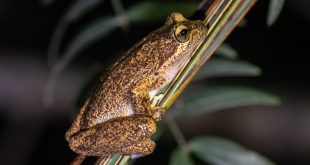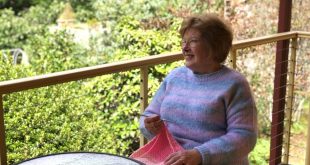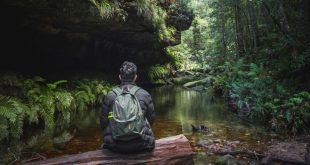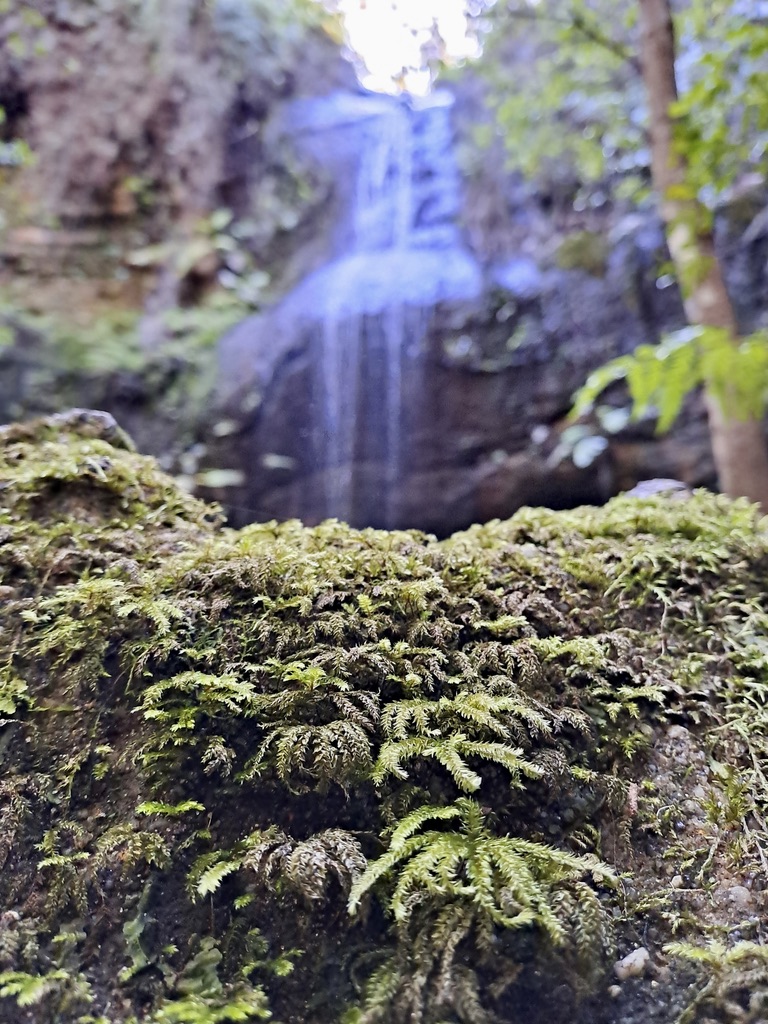
Adelina Falls
Story by Belle Butler and Hamish Dunlop
Photographs by Belle Butler
Belle and Hamish from the Planetary Health Initiative meet up with South Lawson Bushcare volunteers, Peter Ardill and Erst Carmichael. They talk about ecological restoration, volunteering and South Lawson Bushcare’s origins.
Before Lawson was synonymous with one of the first explorers to cross the Blue Mountains, before it was defined by the recognisable buildings of its current township – the historic pub, the iconic Mechanics Institute that greets you as you breach the rise from Sydney – its name recalled something far longer standing, something more quietly significant. ‘Christmas Swamp’, as Lawson was referred to for a time, connected the place and the people with the peaty soils beneath.
“When we refer to it now, it conjures up visions of a vast sponge clinging to the side of the ridge. It is collecting the rains that fall, letting them out in a slow drizzle, and feeding the local creeks and streams that spill off the mountains and plunge towards the greater waters of Dyarubbin (Hawkesbury-Nepean) below.”
Belle Butler
Even before that, Lawson was given a name that related directly to water. 24 Mile Hollow, as it was called for a time, indicated the town’s distance to Dyarubbin. Perhaps unintentionally, these names signified the importance of water to the region. Water that, for millennia before European arrival, had existed in balance with the land: feeding flora and fauna and supporting life from the top of the ridge to the low-lying plains.
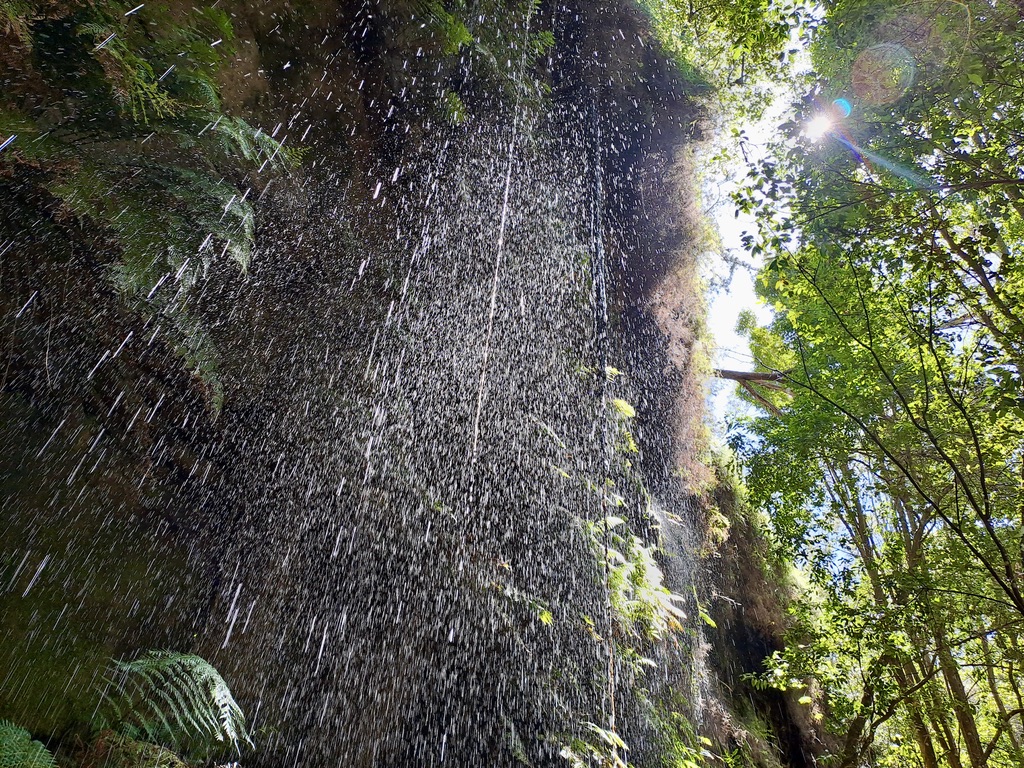
Dripping Swamp at Adelina Falls
A web of connectivity: reducing global warming and climate change
Four of us are standing on the gravel road. Erst Carmichael and Peter Ardill from the South Lawson Bushcare group, and the two of us from Council’s Planetary Health Initiative. We have camera gear. Peter and Erst have various bags including what we recognise as a Streamwatch water testing kit. We’re at the top of the Lawson Creek catchment and about to head down the hill into the bush where South Lawson Bushcare has been working for almost three decades.
The focus of the South Lawson Bushcare group is in the upper catchment of Lawson Creek, located just beneath the town at the edge of newly revived South Lawson Park. The creek starts as a humble trickle, hidden in thick vegetation and fed by tributaries that ooze from the peat soils of the swamp above. As it gathers water and distance from the swamp, it meanders more prettily along the edge of the old golf course, before boldly declaring itself a sight to be seen at Adelina Falls. It grows in confidence as it cuts into the land and spills its silver over the dark rocks of aptly named Junction Falls, just beyond which, Lawson Creek joins forces with Ridge Creek. Further on it merges again, now with Cataract Creek. With the strength of three, it hurtles towards its next point of confluence at Bedford Creek.
Follow these waterways on a map and you will see they are a web of connectivity, performing their own ecological function before joining others and serving a greater purpose. Protecting the stream at the upper catchment is an effective way of protecting everything downstream, just as focussing on one local catchment has broader impact than the localised effect on that one patch of land.
“All the work that we do here is acting as a terrific buffer for the National Park and also for the World Heritage Area (WHA) that is internationally listed,” Peter explains. “We’re actually keeping a lot of the threatening impacts out of that WHA and out of the National Park. So that’s another great benefit of our work. Of course big areas like the WHA serve as massive carbon sinks and they are reducing global warming and climate change. We’re doing it here on a local basis at the top of the creek and in the catchment area, but also we’re helping to maintain those big carbon sinks that are soaking up the CO2 in the atmosphere.”
Peter Ardill
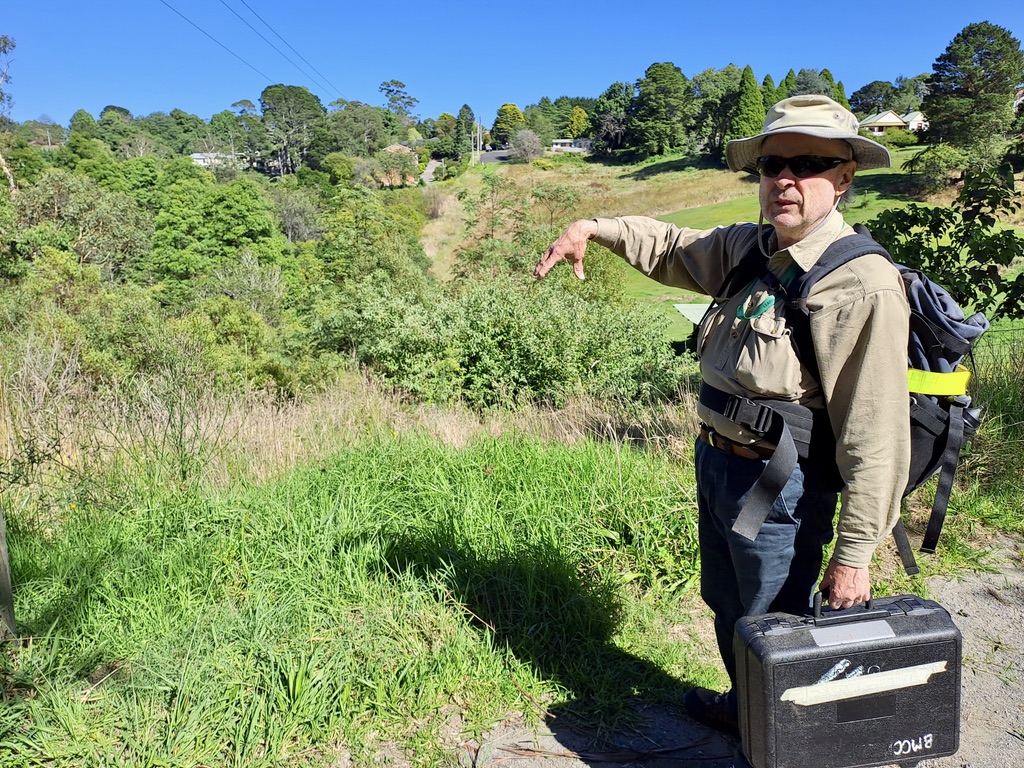
Peter Ardill indicating the location of the swamp that feeds Lawson Creek
Saving the swamp from development
Peter and Erst’s efforts began in 1989 when a developer proposed turning South Lawson’s nine-hole golf course into an international course with luxury resort extending into untouched bushland.
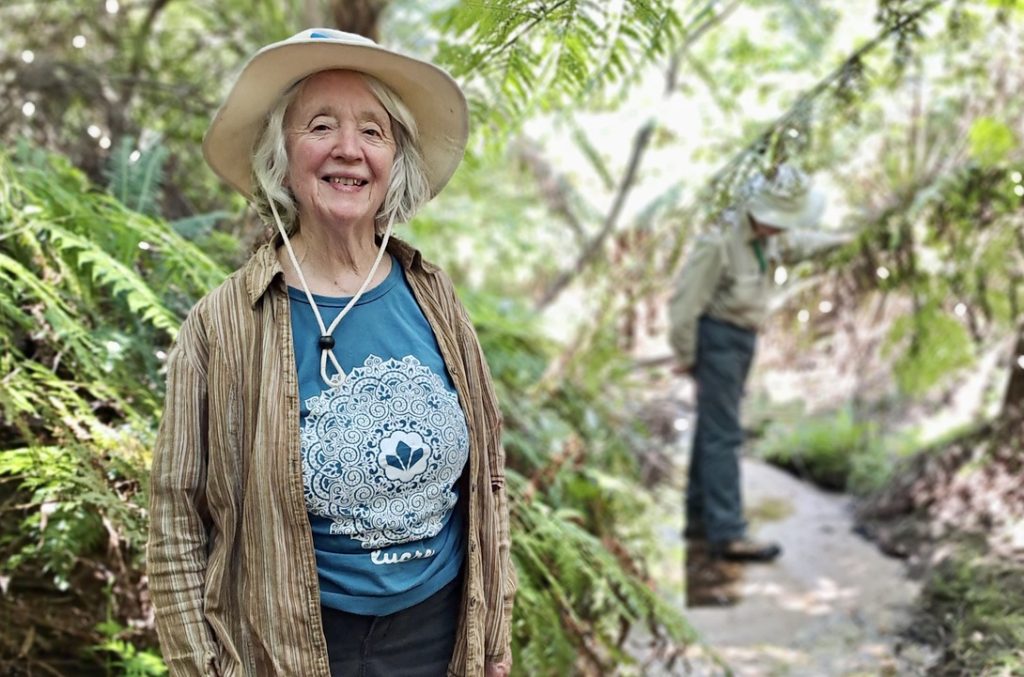
Erst Carmichael at Lawson Creek
“The developers obviously had no idea what the environmental values were,” says Erst, explaining that a group of concerned residents banded together to raise awareness. Peter joined at that point and together they voiced their objection. One of their key concerns was the impact the development would have on the hanging swamp.
“The hanging swamps with their peaty soil store the water and release it slowly over the years and that’s why so many of these streams and waterfalls are perennial.”
Peter Ardill
Peter notes that the regular flow of water leads to habitat enrichment and supports life, including macroinvertebrates that are able to make these waterways their permanent homes. He points out that hanging swamps are listed as a threatened species by state and federal governments. “So they’re very important. They’ve got to be looked after.”
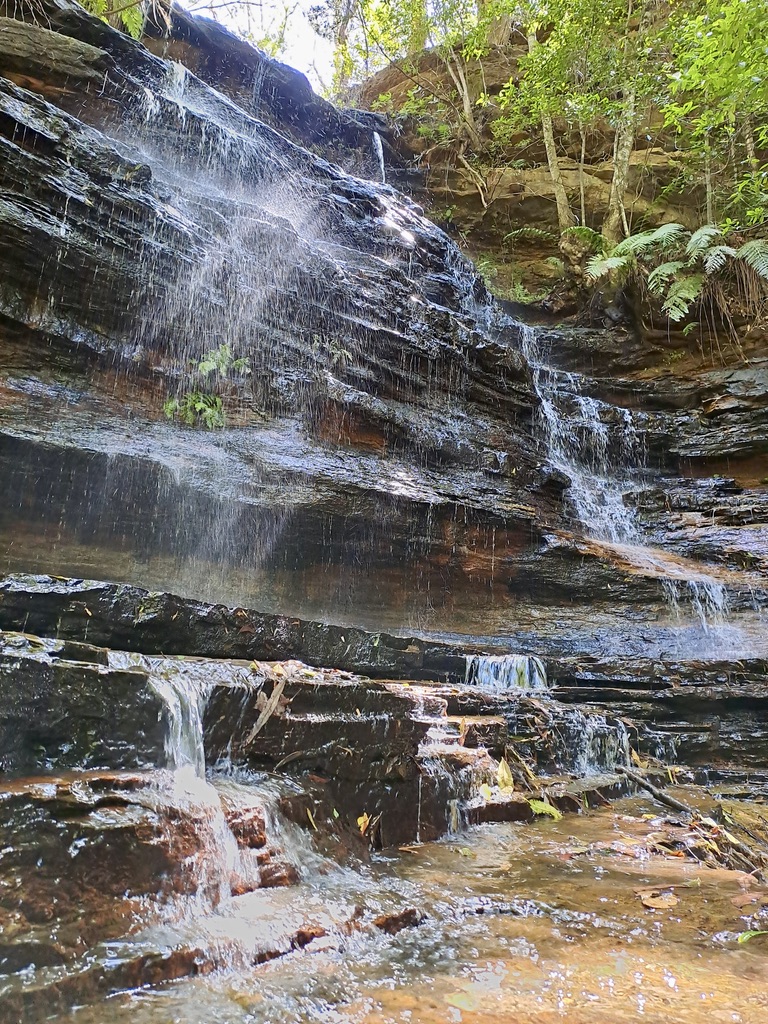
Junction Falls
It took five years of concerted community action before the proposal was rejected. “It was at that point that we actually established the Bushcare group,” Erst explains, “because we realised that the biggest issue was not just preserving community and preserving the small village of Lawson etcetera, but it was the environment.”
Peter leads us in a single file procession down a narrow dirt path with grass weeping in from both sides. We are struck by the weeds and native species co-existing in this area. Erst explains that runoff from the highway and sand from development are key challenges. With this water and runoff from homes comes weeds, their seeds and higher levels of nutrients including phosphorus and nitrogen. These come from various sources including fertilisers and faeces which also bring harmful pathogens and bacteria.
Peter comments that since settler colonialism in 1788, a huge number of plant and animal species have been brought to Australia. He suggests that unlike First Nations people, colonists didn’t understand the local ecosystems and thought they would operate like a little Europe. Swamps were drained, grazing animals introduced and the natural ecosystems degraded. This legacy is being addressed today, but will continually need to be addressed. South Lawson Bushcare manage introduced species including blackberry, privet and Japanese honeysuckle.
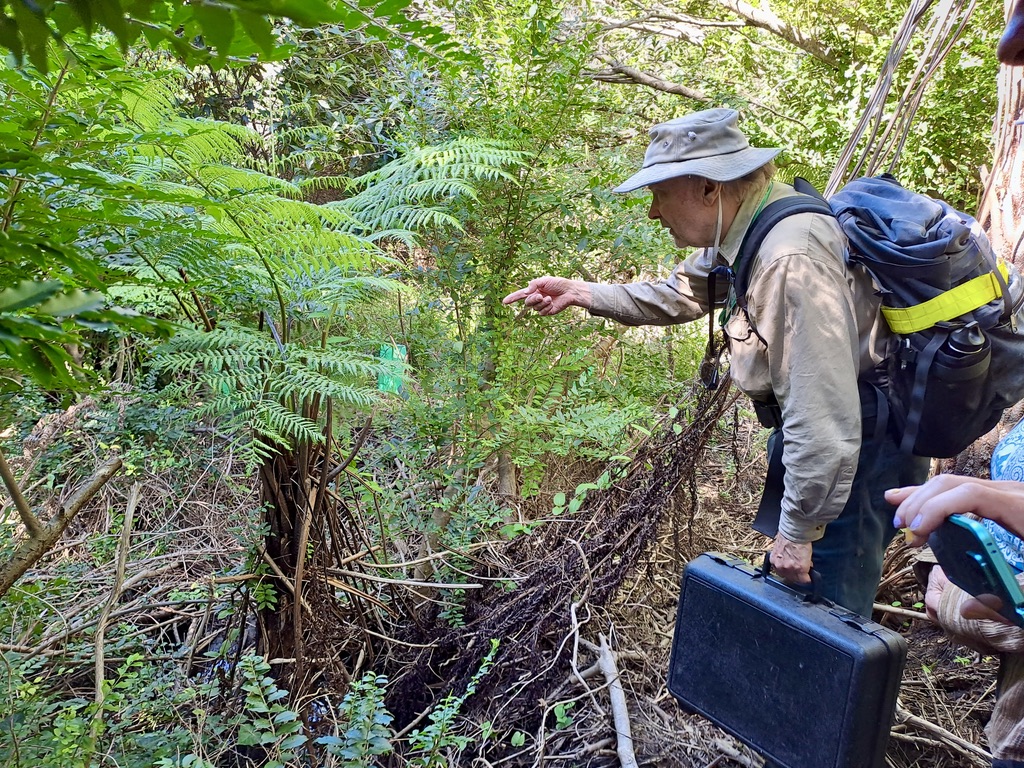
Peter Ardill pointing out weeds
Our impacts on the land and the water that feeds it
Re-naming Lawson in 1879 after a European evokes the multifaceted impact of settler colonisation on the land and the water that feeds it. Even without expanding the golf course, the impacts of development and human activity on the Lawson Creek catchment are significant.
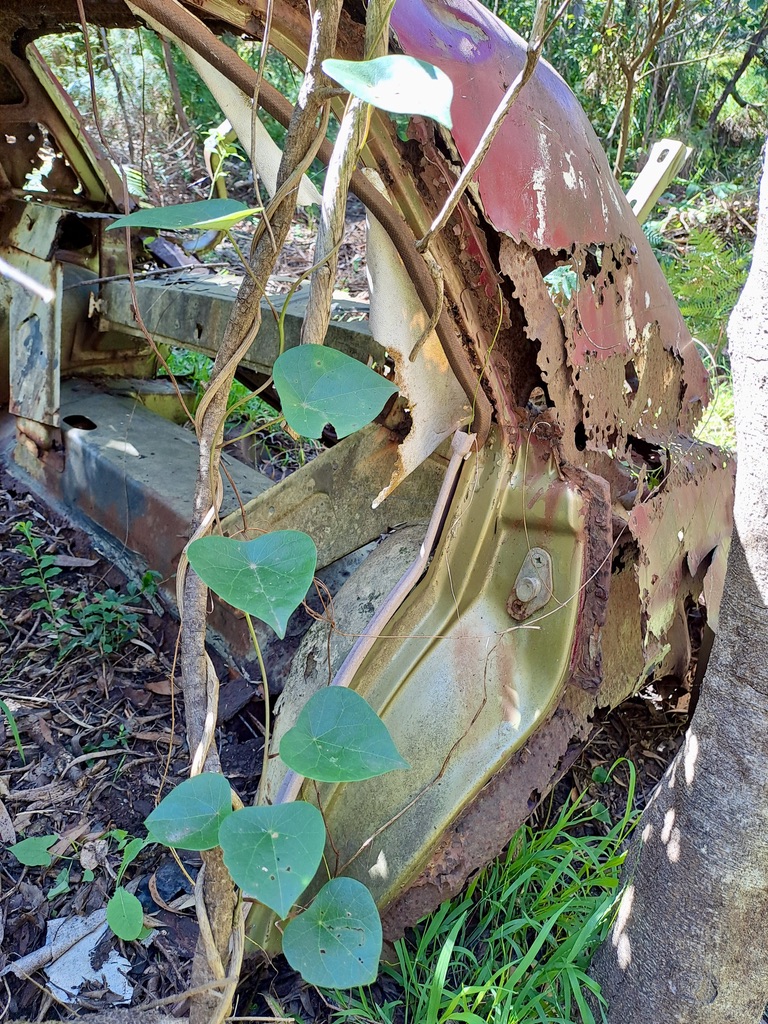
Rusted car
As if placed there as a visual metaphor for this, a dumped car, rusting with age, boldly inhabits one of the focussed areas of the Bushcare group’s efforts. Eventually it will rust away. Already nature appears eager to reclaim it. But for now it reminds us of our presence in this place.
While we walk and chat there is the coming and going of helicopter hum and the rumble of passing planes above. At our feet are weathered but defiantly durable plastics of discarded drink bottles and wrappers. We pick them up and carry on.
Peter points out that unsupervised and off-leash dog activity has had an unfortunate impact on Lawson Creek. Downstream from where we stand the natural ferns along the banks of the creek have been wiped out. Peter explains the knock-on effect of this:
“The next stage will be that the tea trees that are on those banks, they’ll start to collapse, the banks will start to collapse and you’ll get massive damage there and soil running down the creek. It’s of great concern.”
Peter Ardill
To mitigate this impact and complement the work of the Bushcare group, Blue Mountains City Council has provided a dedicated fenced off-leash dog area in South Lawson Park. They have also focussed some of their bush regeneration work in the riparian zone, and installed signage to remind visitors to keep their dogs on-leash unless they are in the enclosed off-leash area.
“There are so many elements to this landscape and the complex history that has been wrought upon it. All of this brings to mind time scales: how long does a plastic bottle persist and how many hundreds of generations have lived on Country? In our society of consumption, our cycle of action and desired reward is blisteringly short. I feel this when I think about the decades that Erst and Peter have been caring for this land. There are still weeds mixed in with natives and I wonder why we can’t just tear all the weeds out. Immediate satisfaction!”
Hamish Dunlop
As if to answer my thoughts, Peter starts talking about the balancing act of bringing in more native species and taking out weeds at the same time.
“It has to happen slowly, gradually” Peter says. “What we’re doing here is ecological restoration. A landscaper might come in with a bulldozer and put in a rockery, but ecological restoration is about a holistic approach. Native and weed species both provide habitat for animals and other creatures for example. We need to consider this. There are crayfish here, possums, antechinus, and swamp wallabies among many others. We need to keep everyone happy.”
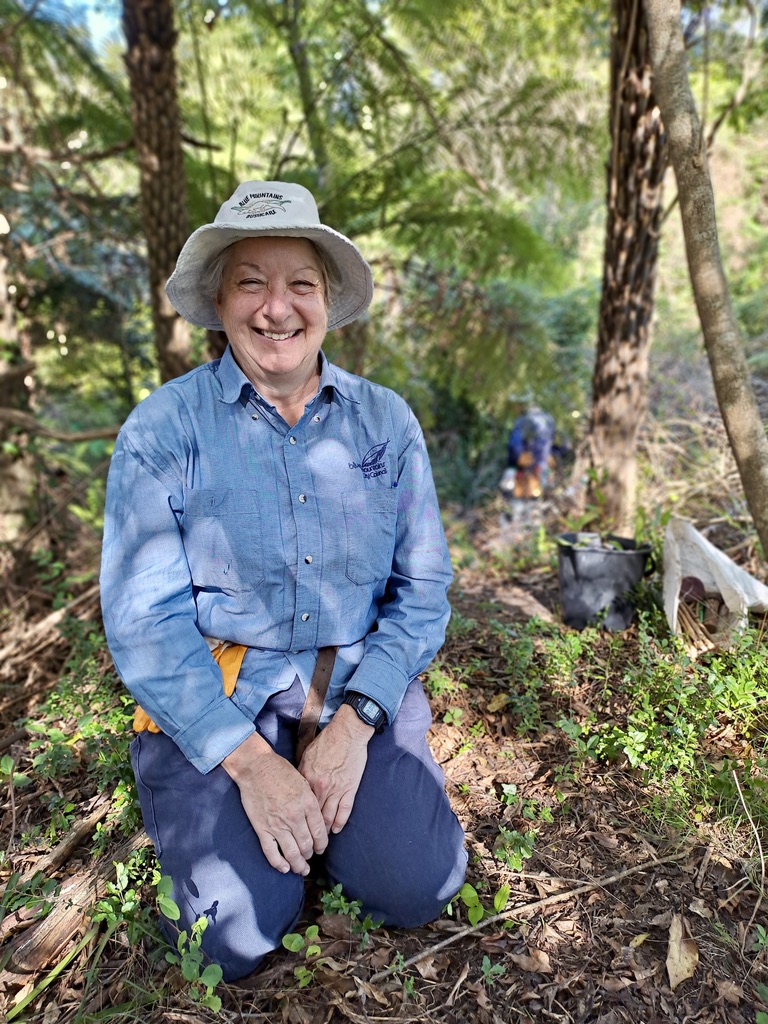
Karen Hising
Later we talked with Karen Hising, Blue Mountains City Council’s Bushcare Officer responsible for South Lawson. She agrees with Peter.
“We practice ‘restoration ecology’. We know that the crayfish like deep shady spots with not too much sun. So here, the weeds are serving an ecological function and we need to not rush in. Animals have made it their homes. If we just take that away, we take away their homes.”
Karen Hising
There is an aspiration to achieve substantial recovery and ecological functioning on the site. But this is something that will happen not just over days, weeks and seasons, but years, decades and beyond. Peter emphasises the importance of social ecology and how it is woven into the fabric of the landscape.
“With a holistic approach, stakeholder and community engagement is incredibly important, in particular with First Nations communities, because this has been neglected in the past but is very very important these days. It’s always been their homelands and it always will be. We need to use science appropriately. Getting the balance right with our levels of interference in the natural world is key.”
Peter Ardill
Peter mentions that research indicates undertaking restoration work is most beneficial at the top of the catchment. “Working at the top of the catchment we can control a lot of the detrimental impacts from going down. At Lawson Creek that’s particularly sediment flows – massive flows of sand and also weed seed.”
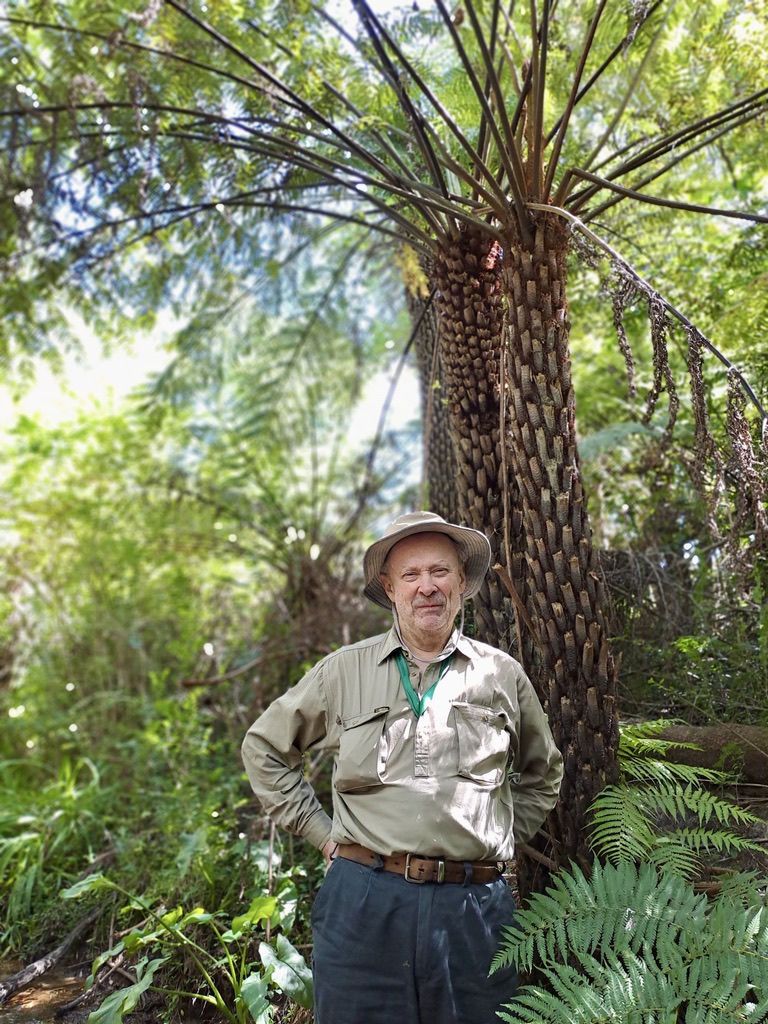
Peter Ardill
At the bottom of the slope the ground begins to level out and become wet underfoot. “This used to be all blackberry,” he says. “You couldn’t walk through here. We’ve been working on it over the last few years with Karen Hising, our wonderful Bushcare officer, and the other volunteers that come. The biggest thing has been to stabilise the ground so that sand is not going down the creek and destroying habitat.” He points to the sticks we can see layered under the surface of the tea-coloured water. “We put these down to slow the movement of sand.” Peter identifies reeds as Juncus microcephalus. “A weed,” he says. “We’re just cutting the seed heads off at the moment because it’s helping with the sand. When La Niña rains subside a bit more, maybe this winter, we’ll start to slowly remove it and introduce natives.”
As we come into a wetland area proper, Peter reaches out and touches some privet. “It’s hard stuff to get rid of,” he says, “but it used to be all the way up the hill where we walked down.” Karen Hising later explains the rationale for gradually removing privet.
“We might take one mature privet out, then leave one alive to hold the soil. We cut it back to one metre so it’s not producing fruit. That leaves space to plant around it.”
Karen Hising
Erst recalls a memory of when her daughter was young: “She would come down with me and help pull out baby privets.” We all laugh because we’re all imagining a small child on the muddy ground triumphantly holding up handfuls of baby green shoots. It must be a nice memory to have and one that tells a story about generations of family caring for the land.
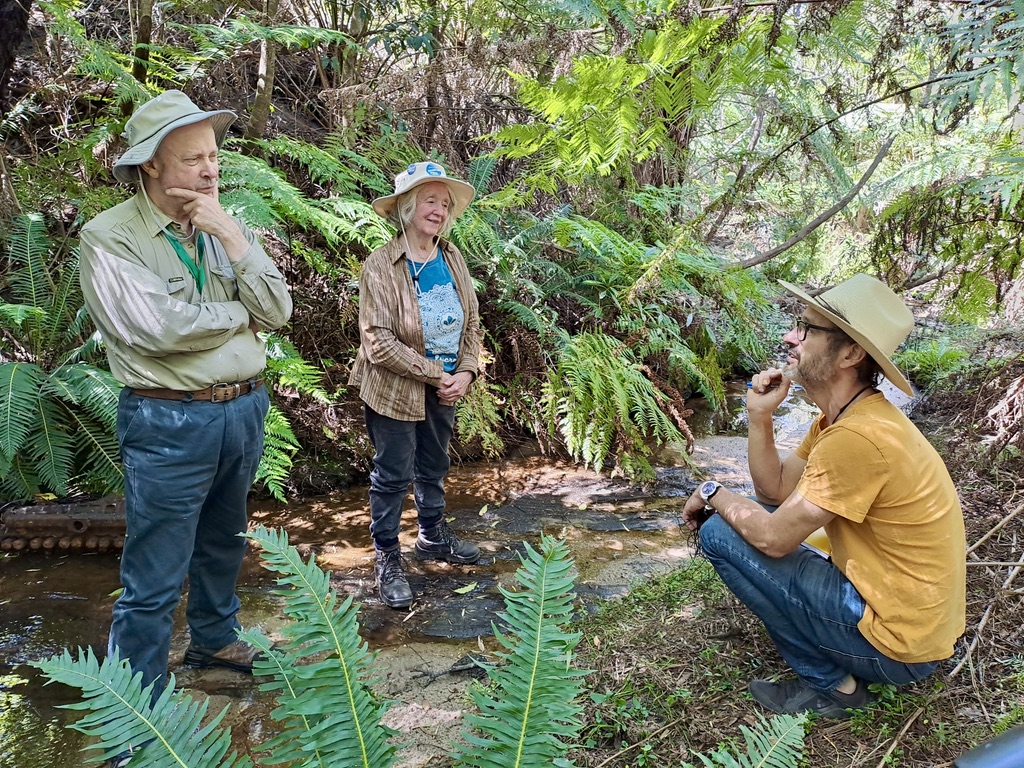
Peter Ardill, Erst Carmichael and Hamish Dunlop
“Just as we’ve noticed the impact of us on this land, we notice the impact of the land on us. When we are quiet we hear the shy gurgle of the stream, the chatter of passing birds, and the dry-leaf scuttle of a skink. When we are still, a dragonfly descends, pauses, and then lands on Hamish’s hand. We huddle around him and admire it, the shimmer of sun in its quaking wings. It appears to trustingly ‘hug’ Hamish’s finger. Perhaps we notice in ourselves a moment of gratitude – the sense of interconnectedness this has brought us – for we are all smiling.
Belle Butler
Erst quietly chuckles. I see in her the same joy she shows when she talks about bringing her daughter to this place to pull out ‘baby privets’. There is a nostalgia in her smile that is familiar to me. As a Lawson resident, I too have spent long hours watching my young children bask in the splendour of these waterways, bare-footed, rock-hopping their way down creeks and calling out at the discovery of crayfish. It was just further downstream that my husband and I seemingly ‘landed upon’ a middle-name for our son. When I tell this to Erst, she lights up and shares that her daughter was named Adelina, after Adelina Falls.”
So it is not just that Erst and the other Bushcare volunteers give to and nurture the land – the land nurtures them too, something First Nations people knew and practiced well before now. “Just being able to spend two to three hours once a month caring for the bush,” says Erst, “it’s a very heart-warming thing to do.”
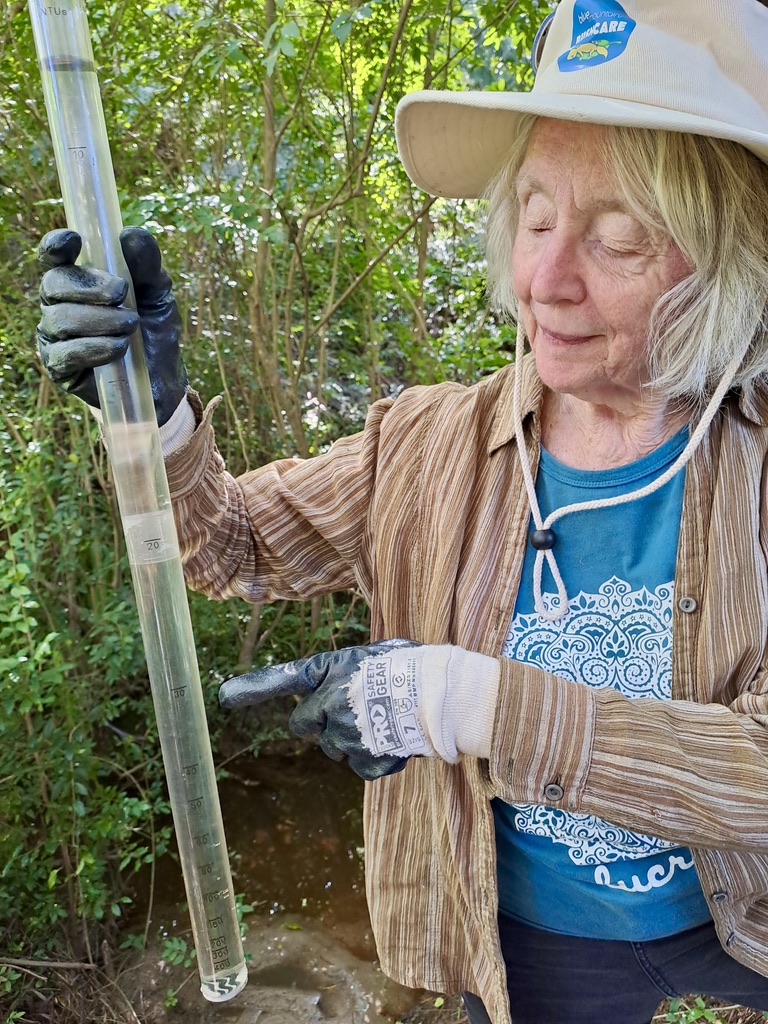
Erst Carmichael testing water
We’re right in the bush now. Peter indicates this is where they do their Streamwatch testing. One of the things we’re interested to find out is the relationship between Bushcare and Streamwatch activities on the site and this seems like a good place to ask.
But before we can get the words out Peter exclaims, “Crayfish! Oh, there’s four – there’s another one there!” He’s delighted. “There’s one over there, and a small one – terrific!” Peter points out their finger-sized burrows in the bank. Erst is also excited. We have seen crayfish before, but it’s lovely to share in their spontaneous joy.
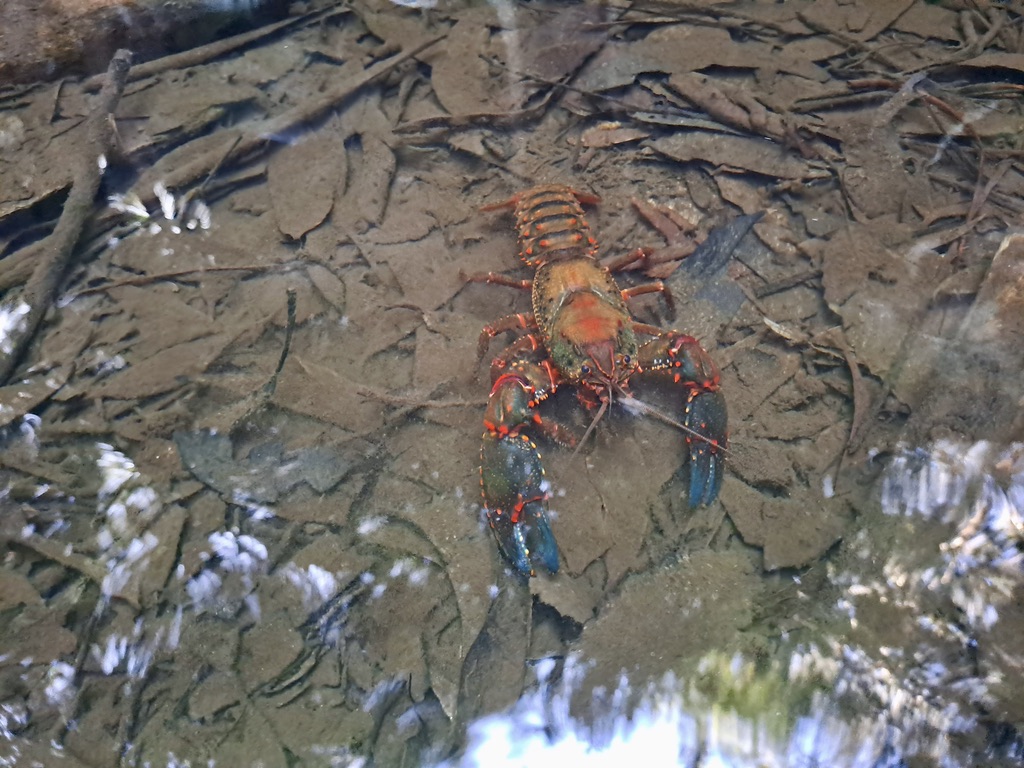
Crayfish near Junction Falls
Returning to our question about the relationship between Bushcare and Streamwatch, Peter explains: “Doing Streamwatch on a Bushcare site contributes significantly to a holistic understanding of that site. Often, weeds are the focus, animals are the focus, streams can get overlooked.” He says that on top of getting an overview of the ecosystem, water can tell us what’s happening with regards to ecological restoration. “We do a range of tests including water pH, dissolved oxygen, phosphorus, nitrogen and turbidity, which is how cloudy the water is as a result of suspended particles. We also look at the health of aquatic macroinvertebrates. These are insects in their nymph and larval stages, worms, snails through to crayfish that spend at least part of their life in water.”
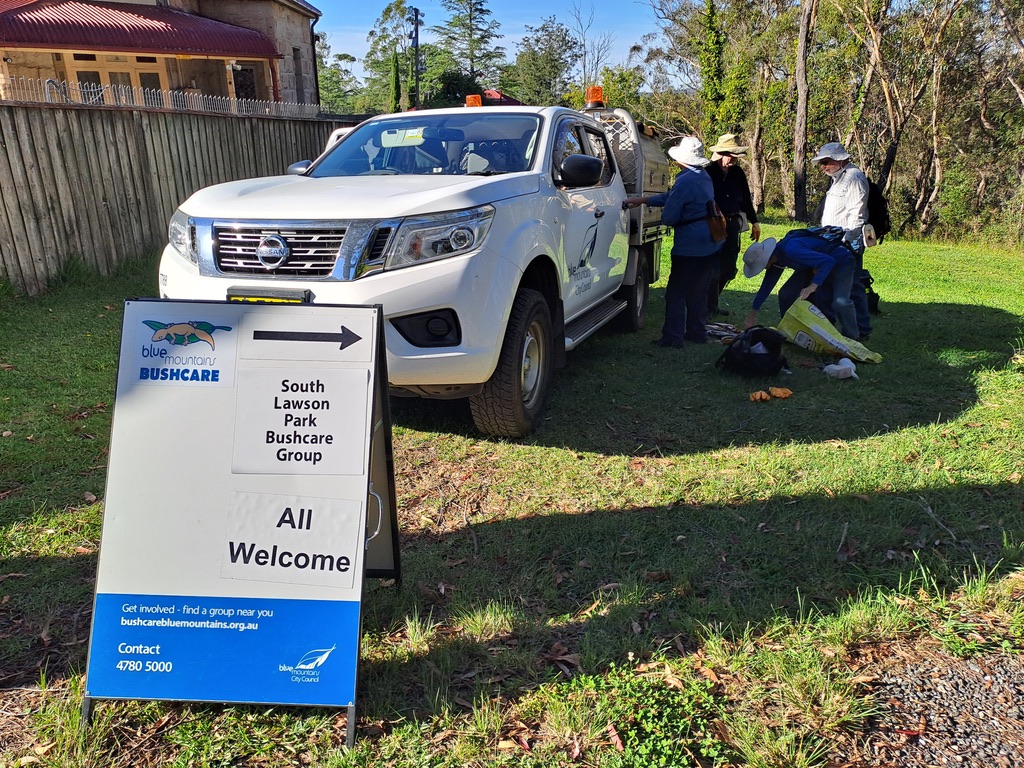
South Lawson Bushcare Group
Belle participates in the Bushcare group a week later
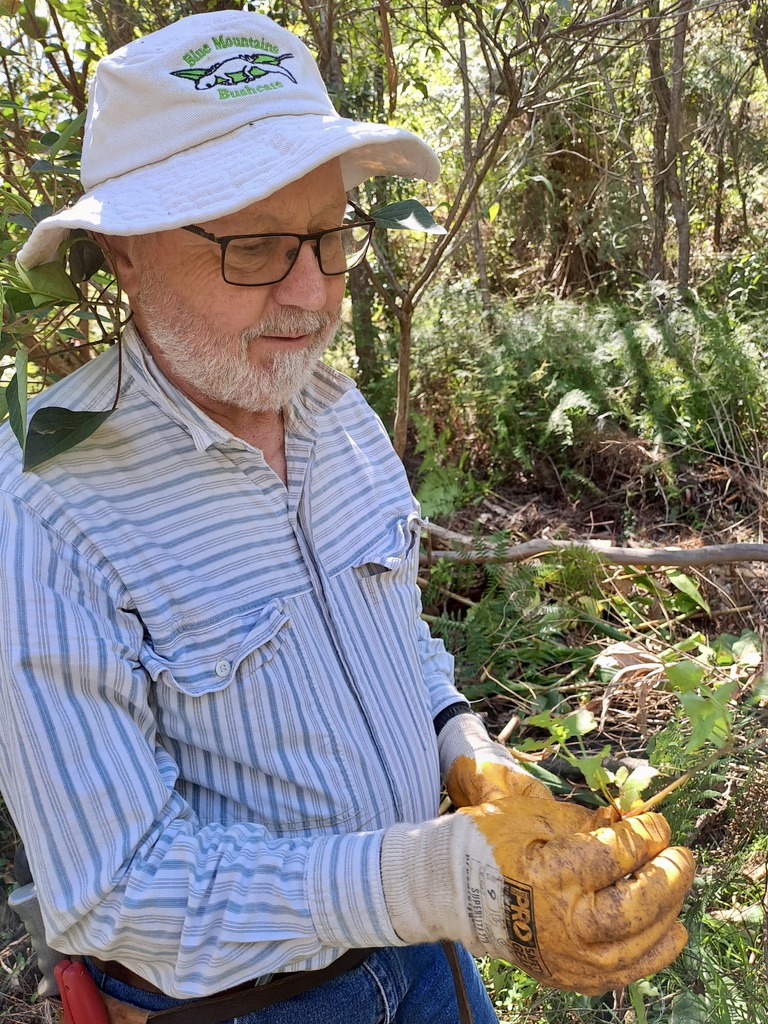
Rob Grieve showing turkey weed
At the South Lawson Bushcare volunteer day, a group of people gather from different backgrounds, all giving a bit of their Sunday to this mutual cause. They have a range of existing knowledge on caring for the bush. It is clear that one of the many benefits to volunteering is sharing and gaining knowledge. One long-standing member, Rob Grieve, mentions that he enjoys the social aspect of the group. Chatting with others while working, he has learnt a lot about weeds and native plants, which has proved useful in managing his own acre of land.
Karen Hising highlights the benefit of knowledge transference. “One way residents can play their part is by looking at their own properties and asking for advice,” she says. “The weed book and our websites are a great place to start.” She welcomes new volunteers to this or any other Bushcare group operating in the Blue Mountains.
It is possible that the small action of one person, one group, one day a month can make a big difference, creating lasting change that generations down the track will enjoy.
“I think the Bushcare network has 70 or 80 groups at the moment and 500 or 600 people. So together, all of these people, they have made a tremendous difference ever since it started. Tonnes of weeds have been removed and natural ecosystems restored right back to a very high level of ecological functioning and independence. We’re actually creating a healthy riparian corridor of indigenous local vegetation. We’ve got swamp wallabies coming up here, we’ve got macroinvertebrate life, there’s lots and lots of indigenous animal species in this corridor. And also, it’s just a beautiful place for the local residents to come and enjoy the walks and bring their kids.”
Peter Ardill
Volunteer groups – Bushcare and Streamwatch among them – mirror the connected web of waterways that, starting as tiny trickles, gather and grow to have a vast impact beyond their local origins. Often small and humble on their own, each volunteer group performs its own purpose to restore the balance of nature in a focussed area of land and water. Together they form a web of connectivity that has a far broader effect than any one group on their own, their work extending a vast reach of positive impact on everything downstream and for generations to come.
If you’d like to join a Bushcare group, please visit: Bushcare Blue Mountains | News and tips for volunteers and friends.
Other useful resources:
Weeds Blue Mountains – Weeds | Cherishing our bushland (weedsbluemountains.org.au)
Swampcare – Swampcare Program | Bushcare Blue Mountains
Remote Programme – Remote Bushcare Program | Bushcare Blue Mountains
Seed Collecting Group – Seed Collection Group | Bushcare Blue Mountains
Events – Upcoming EventsBushcare Blue Mountains
Streamwatch – Streamwatch — NSW Landcare Gateway
This story has been produced as part of a Bioregional Collaboration for Planetary Health and is supported by the Disaster Risk Reduction Fund (DRRF). The DRRF is jointly funded by the Australian and New South Wales governments.
